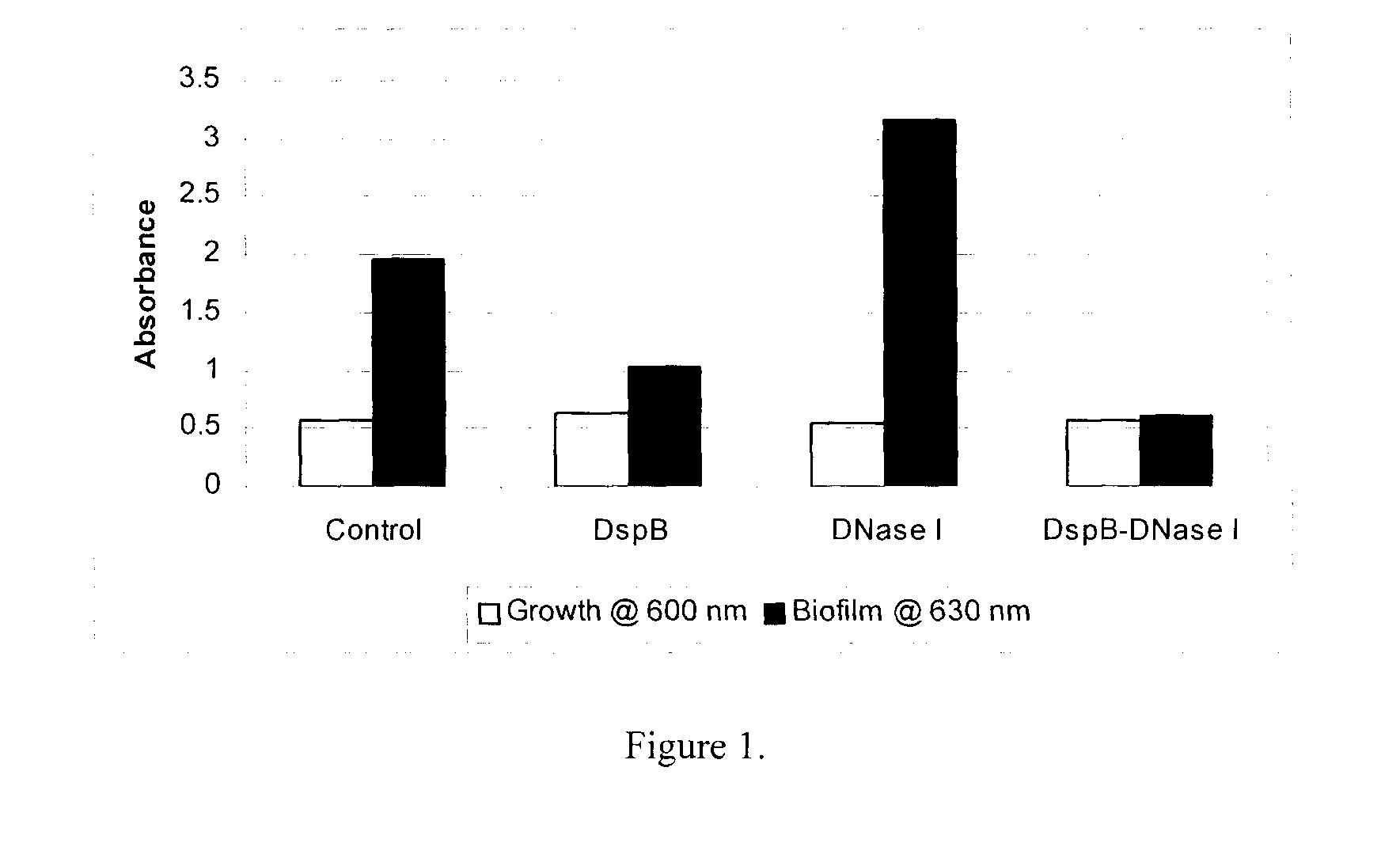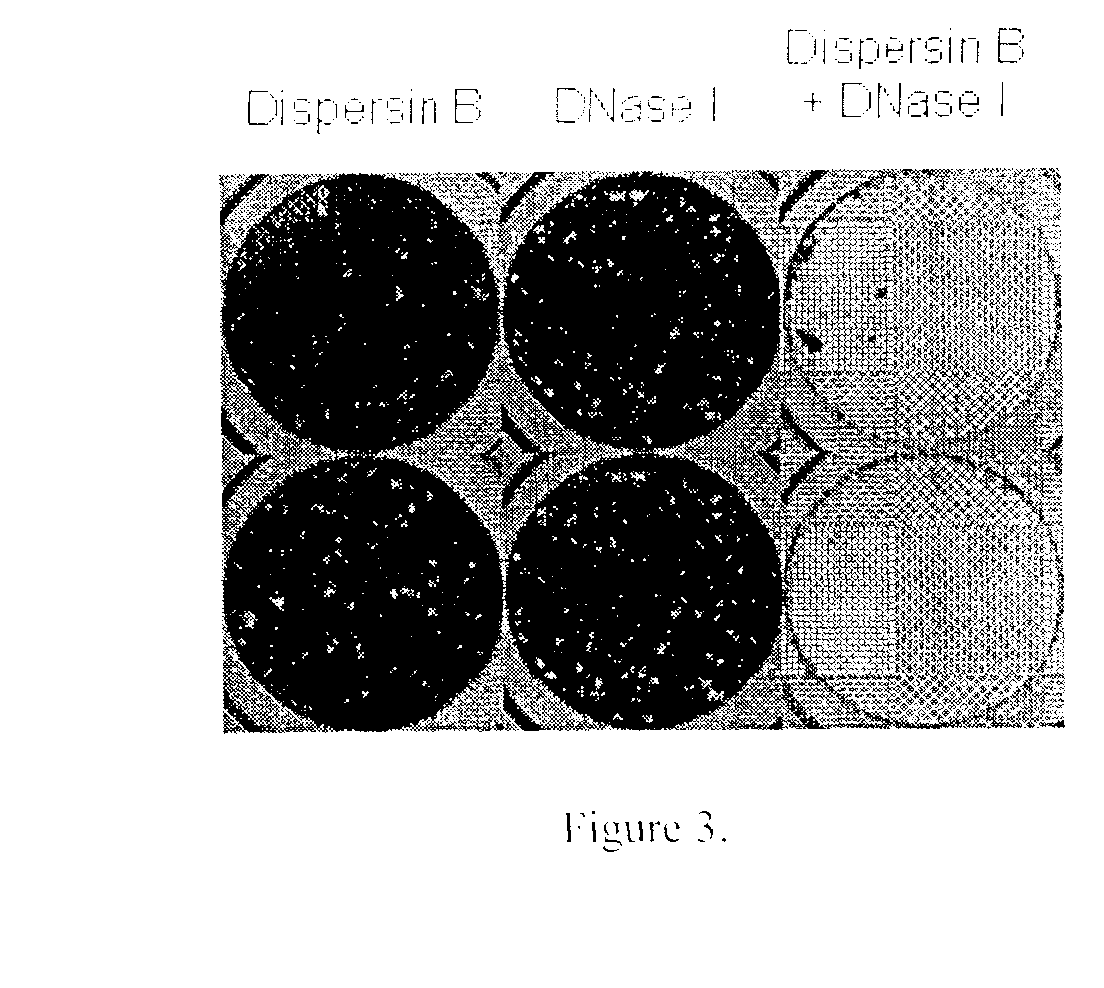Dispersinb, 5-Fluorouracil, Deoxyribonuclease I and Proteinase K-Based Antibiofilm Compositions and Uses Thereof
a technology of deoxyribonuclease i and proteinase k, which is applied in the field of antibiofilm compositions, can solve the problems of increasing the cost of general wound management, increasing the risk of infection of wounds, and increasing the burden on patients, so as to prevent urinary or vascular infection and prevent urinary tract infection
- Summary
- Abstract
- Description
- Claims
- Application Information
AI Technical Summary
Benefits of technology
Problems solved by technology
Method used
Image
Examples
example 1
Effect of DispersinB™ and DNase I on Staphylococcus epidermidis Biofilm Formation
[0159]An in vitro microplate assay was performed to determine the effect of DispersinB™ and DNase I on the growth and biofilm formation of S. epidermidis. An overnight culture of S. epidermidis in Tryptic Soy Broth (TSB) was used as inoculum. S. epidermidis biofilm was grown in TSB in a 96-well microtiterplate in the absence and presence of each enzyme (DispersinB™-1 μg / ml or DNase I-25 μg / ml) separately and together (DispersinB™+DNase I). The plate was incubated at 37° C. for 24 hours (h). Growth of planktonic cells based on the absorbance at 600 nm was determined using Labsystems Multiskan Ascent microplate reader. Biofilm was measured by discarding the medium; rinsing the wells with water (three times), and staining bound cells with crystal violet. The dye was solubilized with 33% acetic acid, and absorbance at 630 nm was determined using a microtiter plate reader. For each experiment, background sta...
example 2
Effect of DispersinB™ and DNase I on Staphylococcus epidermidis Biofilm Dispersal
[0160]An in vitro microplate assay was performed to determine the effect of DispersinB™ and DNase I on the dispersal of S. epidermidis biofilm. S. epidermidis biofilm in absence of enzyme was grown at 37° C. for 24 h as explained in Example 1. The planktonic cells were discarded and biofilm was treated with water (control), and DispersinB™ (10 μg / ml), DNase I (25 μg / ml) alone and in combination (DispersinB™+DNase I) for 2 h at 37° C. Biofilm was measured as explained in Example 1. The combination of DispersinB™ and DNase I provided enhanced dispersion of S. epidermidis biofilm as compared to the enzymes alone (FIG. 2).
example 3
Effect of DispersinB™ and DNase I on Aggregatibacter actinomycetemcomitans Biofilm Dispersal
[0161]An in vitro microplate assay was performed to determine the effect of DispersinB™ and DNase I on the dispersal of A. actinomycetemcomitans biofilm. A. actinomycetemcomitans biofilm in the absence of enzyme was grown at 37° C. for 24 h as explained in Example 1. The planktonic cells were discarded and biofilm was treated with DispersinB™ (20 μg / ml), DNase I (100 μg / ml) alone and in combination (DispersinB™+DNase I) for 1 h at 37° C. Biofilms were then rinsed with water and stained with crystal violet. Duplicate wells are shown in FIG. 3. The combination of DispersinB™ and DNase I provided enhanced dispersion of A. actinomycetemcomitans biofilm as compared to the enzymes alone.
PUM
| Property | Measurement | Unit |
|---|---|---|
| concentration | aaaaa | aaaaa |
| concentration | aaaaa | aaaaa |
| concentration | aaaaa | aaaaa |
Abstract
Description
Claims
Application Information
 Login to View More
Login to View More - R&D
- Intellectual Property
- Life Sciences
- Materials
- Tech Scout
- Unparalleled Data Quality
- Higher Quality Content
- 60% Fewer Hallucinations
Browse by: Latest US Patents, China's latest patents, Technical Efficacy Thesaurus, Application Domain, Technology Topic, Popular Technical Reports.
© 2025 PatSnap. All rights reserved.Legal|Privacy policy|Modern Slavery Act Transparency Statement|Sitemap|About US| Contact US: help@patsnap.com



